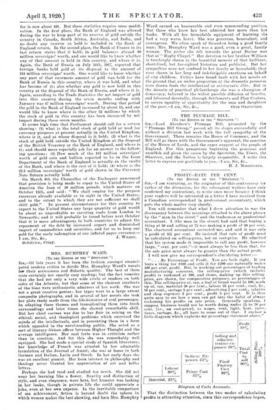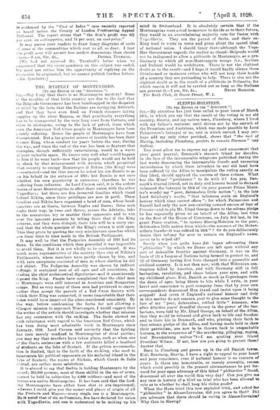PROFIT—RATE PER CENT.
[TO THE EDITOR OF THE " SPECTATOR.' 'I
SIR,—I am venturing, as the originator of this controversy (ot rather of the discussion, for the subsequent writers have only confirmed my contention), to write once more because I think your readers will be interested in a letter I have received from a Canadian correspondent (a professional accountant), which puts the whole matter very clearly.
You will remember that what I drew attention to was the discrepancy between the meanings attached to the above phrase by the "man in the street" and the tradesman or professional accountant. I (the man in the street) had said that buying a thing at 50 and selling at 75 was making a profit of 50 per cent. The chartered accountant corrected-me, and said it was only a profit of 33 per cent. He insisted that rate of profit must be calculated on selling-price, not on cost-price. He admitted that his system made it impossible to call any profit, however large, "cent. per cent."—it must always be less than that, for the sale price must always be greater than the actual profit.
I will now give my correspondent's elucidating letter :— " . . . Re Percentage of Profit. You are both right. If one buys a thing for £100 and hells it for £200 one naturally makes 100 per cent. profit. But, in working out percentages of trading manufacturing concerns, the selling-price (which includes profit) is reckoned at 100, and. items, making up this selling- price, are shown, for comparative purposes, as percentages of this. The selling-price of, say, a loaf of bread would 'be 100, made up of, say, material 50 per cent., labour 25 per cent., coal, &e., 10 per cent., cartage 5 per cent., advertising 2 per cent., calorie. and shop expenses 3 per cent., profit 5 per cent. It is thus quite easy to see how a man can get into the habit of always
reckoning his profits on sale price. Generally speaking, suppose business would not be worth doing under 25 to 30 per cent. [i.e., on cost-price], as wages, rent, light, heat, rates. taxes, cartage, &c., all have to come out of that. I enclose a little diagram which explains my percentage statement above."
Diagram of Costs Accounts.
• That the distinction between the two modes of calculating profits is attracting attention, since this correspondence began, is evidenced by the "Cost of Iodex " case recently reported as heard before the County of London Profiteering Appeal Tribunal. The report states that "the firm's profit was 42# per cent, on selling-price, and 74 per cent, on cost-price."
It may amuse your readers to draw fancy diagrams of costs r,f some of the commodities which cost us all so dear. I fear I he profit area will permit less modest dimensions than shown
bove.—I am, Sir, Fec., PEVERLL TURNBULL. [We had not received Mr. Turnbull's letter when we annoimced that the correspondence on this subject was ended. We must not refuse him the opportunity of replying on the discussion he originated, but we cannot publish further letters. —ED. Spectator.]



































 Previous page
Previous page